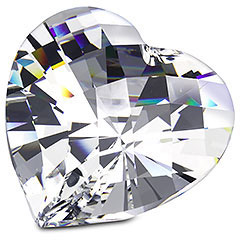Swarovski – A brilliant company
Pioneers were always way ahead of their time. In their minds they conceived the inconceivable. In their fantasies they created the impossible. When he invented an automatic cutting machine at the end of the 19th Century, Daniel Swarovski opened the door to a world of fantasy.
The magic word was crystal. A raw material, which even the most ancient cultures ascribed beneficial, valuable, indeed miraculous properties. This fascinating material transformed the world of fashion and beauty into a seductively sparkling universe. It inspired the human race and enriched both art and culture.
Today crystal has become part of the connection between people. A ray of joy, which we would like to share with you.
Many Swarovski Silver Crystal lovers believe that the raw material used in the manufacture of our crystal objects occurs naturally, like rock crystal from which containers and spheres have been carved since time immemorial. Nothing could be further from the truth. Swarovski Crystal is made at the factory in Wattens using basic formulae perfected by Daniel Swarovski and his three sons.
Swarovski craftsman in Austria, whoheld up a finished piece of crystal to the light inspections,was awed by the silvery glow created by the object’s spectral brilliance. Since then, all pieces in the collection have been called Swarovksi Silver Crystal. Swarovski Silver Crystal if fired using a combinationof natural minerals and quartz sand, and then cooled slowly to avoid stress and inclusions.
According to Swarovski, the company today has 20,000 employees and is run by 4th and 5th generation family members. In 2006 the global turnover was 2.33 billion Euros. The two major divisions consist of the manufacture of loose Swarovski crystals and the second division selling designer driven finished products.
Swarovski (Austrian) Crystal is considered by many people to be the finest quality, full-lead crystal made today. It contains a minimum of 32%PbO, making the crystal optically very pure. The crystal is then faceted with tremendous precision, creating beautiful prisms. Brilliant colors and/or coatings are added to these crystals to create pendants, stones, and beads of dazzling beauty and tremendous variety of shapes and sizes. Swarovski Crystal is unmatched in quality and distinction.
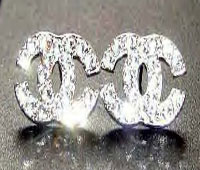 Chanel, Prada, Alexander McQueen, Dolce and Gabbana, Julian Macdonald and also Christopher Bailey at Burberry Prorsum have all incorporated Swarovski into their designs with gusto. Each has imaginatively produced garments of a calibre which can now be labelled CRYSTALLIZED™.
Chanel, Prada, Alexander McQueen, Dolce and Gabbana, Julian Macdonald and also Christopher Bailey at Burberry Prorsum have all incorporated Swarovski into their designs with gusto. Each has imaginatively produced garments of a calibre which can now be labelled CRYSTALLIZED™.
When Daniel Swarovski first brought a sparkle to crystal, over a hundred years ago, he could never have imagined what a development he was setting in motion. With fantasy, intuition and technical finesse, he and his ancestors have managed to expose all the facets hidden within this fascinating material. Today, sparkling Crystal Components in thousands of colors, shapes and sizes provide a fantastic palette of inspiration for designers and manufacturers. Over and above this, we create jewelry, accessories and a stunning cornucopia of sparkling objects which make ideal gifts and collectibles
Swarovski Timeline
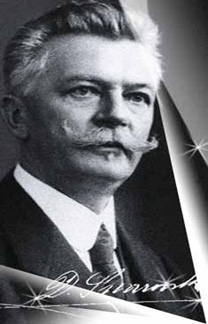 1862 – Daniel Swarovski – The play of light in crystal must have fascinated Daniel Swarovski from early childhood. He was born in 1862 in Bohemia where crystal defined life in his parents’ house. Bohemia, at that time part of the Austro-Hungarian Empire, was one of the most important manufacturing centers for glass and crystal. Crystal was also cut in his father’s small factory.
1862 – Daniel Swarovski – The play of light in crystal must have fascinated Daniel Swarovski from early childhood. He was born in 1862 in Bohemia where crystal defined life in his parents’ house. Bohemia, at that time part of the Austro-Hungarian Empire, was one of the most important manufacturing centers for glass and crystal. Crystal was also cut in his father’s small factory.
As a young boy Daniel often watched the work in his father’s business. Later he completed his apprenticeship with his father, as well as at several other crystal-cutters. When, at the age of 21, he visited the “1. Elektrische Ausstellung” (First Electrical Exhibition) in Vienna, he had the idea of his life: the new techniques from Siemens and Edison inspired him to develop a machine for cutting crystal. He worked day and night at realizing his vision. Finally, nine years later (1892), he was ready to register a patent: a machine which, for the first time, made it possible to cut crystal to perfection. It was far faster and more precise than the manual work to date.
Thus began a new era in the world of crystal. The foundations had been laid for today’s company. Daniel Swarovski together with his brother-in-law Franz Weis and with Armand Kosmann founded it in 1895
A PRECONDITION OF YOUR LONG-TERM SUCCESS IS THAT YOU ENDEAVOR TO THINK NOT ONLY OF YOURSELVES BUT ALSO OF YOUR FELLOW HUMAN BEINGS. THOSE WHO ADHERE TO THIS CONDITION WILL CERTAINLY BE BLESSED WITH SUCCESS.~DANIEL SWAROVSKI
By 1913 the Swarovski Company built their own production plant. It took the years between 1908 and 1913 to perfect the formula for flawless crystal. This was done primarily by Daniel’s sons Wilhelm, Friedrich, and Alfred who followed in their fathers footsteps. These crystals were made into flawlessly cut jewelry stones. Their goal was to create the very finest crystal in the world and to meet production demands that were growing every year.
1917: Company begins development of cutting and grinding tools.
These stone caused quite a stir in the fashion world of the 1920s and demand grew worldwide. The “flapper” fashion for fringed and crystal creations brought about another patent. A ribbon of fabric studded with crystals ready to sewn onto any garment. Fashion designers like Chanel and Schaparelli made costume jewelry not just acceptable but a fashion requirement for every fashion conscious woman of the time.
The company is also renowned for its optical products. Swarovski’s binoculars and telescopesare ergonomic, elegant, well balanced and without frills.
1935: Daniel’s eldest son, Wilhelm, produces the first prototype pair of binoculars, laying the foundations for Swarovski’s Optik products division.
1939: Daniel Swarovski & Co. begins production of optical lenses.
1945: Company launches its eyeglass lenses line.
1948: Company begins marketing binoculars.
1949: Swarovski Optik is formed.
1955: Company creates Aurora Borealis crystal in collaboration with Christian Dior.
1956: January 23, the death of Daniel Swarovski I at the age of 94.
Aurora Borealis was the next innovation in the crystal fashion world in 1956. Crystals were coated with an almost imperceptible layer of metal to give the stone a rainbow sparkle. Manfred Swarovski, Daniel’s grandson worked with Christian Dior to perfect this process.
1957: Company sets up its own gem-cutting department.
1960: The first sales team is founded in Kaufbeuren, Germany. Company opens production facility Abrasivos Austromex in Mexico City.
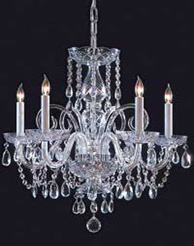 1965: Swarovski starts producing chandelier parts, later known under the “STRASS” trademark.
1965: Swarovski starts producing chandelier parts, later known under the “STRASS” trademark.
1972: Swarovski is the main supplier of the popular “Moodstone”, which changes color according to the mood of the person wearing it.
1976: Four crystal chandelier parts glued together create the first member of Swarovski’s full cut crystal animal menagerie: the tiny mouse! designed by Max Schreck, now deceased. Swarovski Silver Crystal is born! Production of paperweights and key rings began as souvenirs. By 1976, Swarovski’s business expanded from that of a cutting, manufacturing, and jewelry production facility to a business committed to silver crystal as an end product for figurines and collectibles. The first crystal collectible sold by Swarovski was that mouse figurine. The mouse, a best seller at the Innsbruck Olympic Games, enjoyed prominence throughout the world.
1977: Swarovski launches its own jewelry line under its current Swarovski “Jeweler’s Collection” label. The world saw the introduction of a new material and Swarovski branches out to create a new synthetic stone. Cubic Zirconia is the imitation stone that most closely matches a natural stone in sparkle and brilliance. That produced a revolution in the jewelry business and CZ jewelry was all the rage. Anyone could now wear these diamond simulants.
1979: Swarovski establishes a branch in Cranston, R.I., USA, now major headquarters for North American operations.
1987: The Swarovski Collectors Society (SCS) is founded, in response to countless requests from crystal lovers all over the world. The “Lovebirds”, designed by Max Schreck and Adi Stocker, the 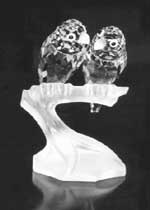 only annuals ever produced by two designers, becomes the first annual limited edition at a retail issue price of $150.00! Estimated Value today $4,500.00!! Interestingly enough, Adi Stocker is not allowed to sign this piece at any of the current Swarovski Events or Galas. What began as a small group of SCS collectors now has a membership in excess of 450,000 + members worldwide!
only annuals ever produced by two designers, becomes the first annual limited edition at a retail issue price of $150.00! Estimated Value today $4,500.00!! Interestingly enough, Adi Stocker is not allowed to sign this piece at any of the current Swarovski Events or Galas. What began as a small group of SCS collectors now has a membership in excess of 450,000 + members worldwide!
Swarovski Silver Crystal is “man-made” and produced by combining a variety of different minerals, including quartz and lead oxide. The manufacturing process uses full lead crystal containing more than 30% lead oxide, producing a crystal with a “deep color spectrum”. Swarovski Silver Crystal produces a more brilliant color than natural rock crystal.
1988: Swarovski’s “SCS Block” trademark is replaced by the Swan Logo.
1989: Unveiling of the Daniel Swarovski line of haute couture accessories and decorative crystal “objects d’arte” at the Hotel Crillon in Paris. Pieces created by top designers, such as: Ettore Sottsass, Stefano Ricci, lessandro Mendini and Hervé Léger. This is Swarovski’s “top of the line” product, often produced in very limited quantities at prices not for the faint of heart! or the average collector.
1991: Swarovski opens lavish new premises, designed by architect Roland Deleu, in the Rue Royale, Paris.
1992: Tyrolit opens new Stans, Austria plant. Launch of the 12-piece Swarovski “Selection” collection by well-known contemporary designers. Selection is considered the second top of the line product in the hierarchy of product lines, and again is often produced in limited quantities, at prices that can be afforded, but not easily afforded. Crystal Memories, as a “trial” product line, was introduced to a single chain of collectible stores in the United States.
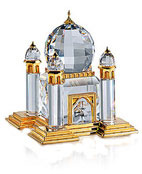 1993: “Official” Introduction of the “Crystal Memories” line began. Two pieces that were offered during the “trial” run, the “Rolling Pin” and the “Coffee Pot” were discontinued and not offered to retailers. These pieces are a very RARE find, were unmarked, and are worth a lot of money today! No one has ever seen the Coffee Pot. From 1993 to 1995, it is not unusual to find Crystal Memories pieces without a logo.
1993: “Official” Introduction of the “Crystal Memories” line began. Two pieces that were offered during the “trial” run, the “Rolling Pin” and the “Coffee Pot” were discontinued and not offered to retailers. These pieces are a very RARE find, were unmarked, and are worth a lot of money today! No one has ever seen the Coffee Pot. From 1993 to 1995, it is not unusual to find Crystal Memories pieces without a logo.
1995: To cut hard materials such as crystal and gems in such a way that they have a hundred identical facets in several directions is a very complicated task: each direction of the reflected light must first be calculated by computer, then this has to be simulated in 3D, optimized and finally converted into control programs for complex machinery. In 1995, thanks to the latest computer technology, Swarovski was able to perfect this type of hi-tech fine cutting technique
In 1995 Swarovski celebrated 100 years of the worlds finest crystal and opened the “Swarovski Kristallwelten” a manmade grotto filled with the most magnificent crystal creations. Designs from the most celebrated artists were created and put on display in a specially designed “Crystal World” in Wattens, Austria. Swan logo added to the “Crystal Memories” collection.
1997: Tyrolit opens new Stans, Austria plant.
Crystal Tattoos were announced in 1999 and now they could be attached directly on the body, no fabric required. Demand for these gems as well as all the other Swarovski products is growing steadily. The Angel ornament became the first “limited edition” in the Crystal Memories line of products (ltd. to 68,000 or less, the U.S. received 28,000 of these). This was followed by two more limited edition “Angels” in 1997 and 1998. 2 more “Angels” have been added to the line in 1999 and 2000, but they are not considered limited editions.
2000: The Daniel Swarovski Paris “Paradise” Line is introduced. Company forms Signity joint venture.
2001: Swarovski Creative Service Centers, which provide business customers with trend consulting, inspiration and product information, are opened in São Paulo and Dubai as part of a global network including centers in Wattens (1995), Paris (1999), New York (1999), London (2000) and Milan (2000).
2002: Taking chandeliers seriously as an art form, the Crystal Palace Collection is launched, complete with contemporary interpretations of the classic chandelier by Ron Arad and Tord Boontje. Each year, renowned designers add avant-garde lighting creations to the collection.
2003: André Heller designs a number of new Chambers of Wonder for the Swarovski Kristallwelten. · Swarovski develops Crystal Fabric, a method of adding countless tiny crystals to fabrics for a delicate shimmering effect. Runway Rocks – a collection of specially commissioned, one-of-a-kind couture jewels created for the catwalk by the world’s leading names in fashion and jewelry design. Runway Rocks is a celebration of design and innovation where crystal is the hero and the vital creative ingredient of each provocative jewel.
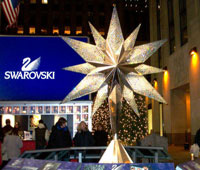 2004: Swarovski develops the XILION cut, a crystal with alternating sizes of facets that enhance the refraction of light for even more sparkle. Swarovski created the 9 foot diameter, 550 pound star that tops the Rockefeller Center Christmas Tree in New York City for the first of five consecutive years.
2004: Swarovski develops the XILION cut, a crystal with alternating sizes of facets that enhance the refraction of light for even more sparkle. Swarovski created the 9 foot diameter, 550 pound star that tops the Rockefeller Center Christmas Tree in New York City for the first of five consecutive years.
Swarovski was also a sponsor for “The Phantom of the Opera” (2004 film), in which the “standing model” of the chandelier was composed of Swarovski crystals. A Swarovski shop window is also visible later in the film. However instead of using the edelweiss flower, which would have been the case in the era the film was set, the current swan logo was used instead.
2005: The first publication on the brand Daniel Swarovski “A World of Beauty” is launched, giving an insight into the creative vision behind Daniel Swarovski and the impact of crystal on the world of fashion and interior design. · Swarovski, in cooperation with Kludi, the German manufacturers of quality bathroom fixtures and fittings, launches the exclusive “Swarovski bathroom made by Kludi”. · Swarovski Fashion Rocks is staged in Monte Carlo – a major charity gala that couples rock stars and leading fashion designers.
2006: Swarovski launches its first ever cohesive brand campaign: The Three Graces. In November 2006 Swarovski acquires the remaining 50% of Signity, which then becomes 100%-owned and part of the Swarovski Group.
2007: CRYSTALLIZED™ – Swarovski Elements, the new product brand for loose crystal is launched. The Swarovski Kristallwelten will be extended with new Chambers of Wonders and bigger store, including the first CRYSTALLIZED™ Cosmos. Swarovski opens an additional 96 own shops in countries around the world.In 2007 Swarovski also launched the product brand web site crystallized.com which provides information for designers and manufacturers in the worlds of fashion, jewelry, accessories and interiors. Crystallized – Swarovski Elements is the new product brand for Swarovski crystals in a variety of sizes, shapes and colours. Products that are labeled with this brand guarantee the originality of Swarovski crystals used in creations of international fashion houses and designers.
2008: ENLIGHTENED™ – Swarovski Elements, the new product brand for genuine gemstones and created stones is launched.
2010: Swarovski polished its first stability report that outlines Swarovski activities in the area of suitability and promoting its its social and ecological values.
2011: Swarovski launches its first perfume, Aura by Swarovski. Touchstone Crystal, a new Swarovski business, opens in United States and offers customers more ways to enjoy jewelry from Swarovski. Touchstone jewelry is made with Swarovski crystals.
2012: Brilliant Redefined with XIRIUS 1088. Swarovski sets new standards in precision cutting of the stone with the release of Xirius 1088. The new generation of crystal is taking it one step closer to a diamond with gemstone-like cut, rich color enhanced foiling produce. Lola & Grace line of jewelry was launched.
2013: Arrival of new jewelry brands. Swarovski launches Cadenzza, a multi-brand retail concept selling hand-picked pieces from over 60 top jewelry designers like Versace, Mawi and Atelier Swarovski. Swarovski also acquires Chamilia, a company that offers beads and charms.
 2014: Swarovski launches its line Atelier, jewelry that is made with semi-precious and precious Swarovski Genuine Gemstones including Sapphire, Topaz, Amethyst and hand-set in 18K gold. Miranda Kerr (famous Victoria’s Secret Model) becomes a face of Swarovski for 2014-2015 jewelry collection.
2014: Swarovski launches its line Atelier, jewelry that is made with semi-precious and precious Swarovski Genuine Gemstones including Sapphire, Topaz, Amethyst and hand-set in 18K gold. Miranda Kerr (famous Victoria’s Secret Model) becomes a face of Swarovski for 2014-2015 jewelry collection.
2016: Karlie Kloss drips in Swarovski crystals as she replaces Miranda Kerr as new face of jewelry brand.
Corporate Facts
SWAROVSKI CRYSTAL BUSINESS
Swarovski designs, manufactures, and sells jewelry and high-quality crystal, genuine gemstones, created stones, and finished products such as accessories and lighting solutions. What started in 1895 as small crystal manufacturing business in Wattens, Austria, has grown to be a global company making every day extraordinary. With a rich history and a culture of creativity, Swarovski is committed to growth and to maintaining its place at the forefront of design, creativity and technological innovation. Swarovski’s products are sold in approximately 170 countries and production locations are in Austria, China, Czech Republic, India, Liechtenstein, Thailand, Vietnam, and the US.
TYROLIT
As one of the world’s leading manufacturers of bonded grinding, cutting, sawing, drilling and dressing tools and a system supplier of tools and machines for the construction industry, the family-run Tyrolit company has been synonymous with superior quality, innovative spirit and outstanding service since 1919. Day in, day out the experts at Tyrolit are busy working on solutions that accommodate the individual requirements of customers around the world; thus contributing to their business success. Some 80,000 available products set the standard in various industrial sectors.
SWAROVSKI OPTIK
Swarovski Optik is a leading supplier of long-range binoculars, scopes and optic accessories for hunting, nature observation, travel and leisure. Swarovski Optik products combine maximum precision, state-of-the art technology and the highest quality standards to constantly improve and bring you the latest innovations in optic technology. The company was founded by Wilhem Swarovski in 1949. An avid astronomer, Wilhelm used the production and finishing technology used to manufacture Swarovski crystal jewelry stones to craft his own binoculars.
SWAROVSKI STATISTICS as of 2015
SWAROVSKI GROUP
Revenue: EUR 3.37 billion
Number of employees: approx. 31,000
SWAROVSKI CRYSTAL BUSINESS
Revenue: EUR 2.6 billion
Number of employees: approx. 26,000
Total number of stores worldwide: approx. 2,680
Number of countries with a brand presence: approx. 170
TYROLIT
Turnover: EUR 643 million
Number of employees: over 4,500 employees
Production facilities: 29 facilities in 12 countries
Sales locations: Argentina, Australia, Austria, Belgium, Brazil, Canada, China, Czech Republic, Denmark, Estonia, Finland, France, Germany, Hungary, India, Indonesia, Italy, Netherlands, Norway, Poland, Portugal, Russia, South Africa, Spain, Sweden, Switzerland, Thailand, UK, UAE and the USA
SWAROVSKI OPTIK
2015 Turnover: 132 million euros
Employees: over 800 employees
Research & Development Employees: 37
Production Facilities: 1 facility located in Tyrol, Austria
Company Locations: Represented in 89 countries across the globe with direct sales operations in more than 40 countries
Source: www.swarovskigroup.com

